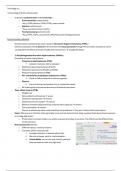Toxicology of …
1) Toxicology of food contaminants
- Important contaminants in the food chain
o Environmental contaminants
→e.g. POPs (dioxins, PCBs, PFAS), heavy metals
o Natural contaminants
→e.g. mycotoxins (from molds)
o Food processing contaminants
→e.g. PAHs, HCAs, acrylamide, 3MCPD (lecture heating products)
Environmental pollutants
- Environmental contaminants major classes: Persistent Organic Pollutants (POPs) =
Chemical substances that persist in the environment bioaccumulate through the food web, and pose a risk of
causing adverse effects to human health and environment. → Categories below
- 1) PolyHalogenated Aromatic Hydrocarbons (PHAHs)
Generally aromatic ring systems.
o Polychlorinated biphenyls (PCB)
▪ Isolation material, flame retardant
o Polychlorinated dibenzofurans (PCDF)
o Polychlorinated dioxins (PCDD eg TCDD)
o Polybrominated biphenyls (PBB)
o Per- and polyfluoroalkylated substances (PFAS)
▪ Used on Teflon material in kitchen supplies.
o Dioxins
▪ Formed during combustion (of e.g. household waste).
o All entering the environment because of industrial processes.
- Toxic effect dioxins/PCBs
o Weight loss
o Skin problems (chloracne) → acute
o Disturbed reproduction → chronic
o Disturbed immune system → chronic
o Behavior disorders (hyperactivity, reduced learn capacity) → chronic
o Tumor formation → chronic
Once it is initiated by other chemicals they can proliferate it. They don’t induce them themselves.
- Exam: Why are we in the food chain generally more worried about chronic daily exposure than about acute exposure
to a single high dose?
o If food chain is contaminated, you will be exposed everyday to low level. The effects can be different than
acute exposure.
- Risk assessment dioxins:
o Different values, made by experts
o Currently: EFSA, value per day
▪ Average consumer is already above this.
▪ We can no longer say it is a safe situation.
▪ Unavoidable, so you can only monitor well and
take out batches with very high level.
, - Also for PFAS parts of the population exceed TWI, which is of concern.
o Extremely persistent: H’s have been replaced for F’s
o Once made, they will be there forever
o Levels were always the same, only the safe limit has changed due to recent data.
o Thousand of chemicals.
o Already in 2004 PFOS was no longer allowed on the market.
2020, the related PFAS PFOA was not allowed.
Now: Restriction proposal on all PFAS, now ECHA is looking at it.
- 2) Organochlorine insecticides (OCs)
o Known since previous century already
→e.g. g HCH (Lindane), Aldrin (HHDN), p,p’-DDT, Dieldrin (HEODD)
- Dichlorodiphenyltrichloroethane (DDT)
o Used in 1945
o Before the dangers were known, people were sprayed with the chemical to protect against bothersome
insects.
o Typhus outbreaks were stopped by DDT, sprayed directly on people, clothing and bedding – even over entire
cities
o Still used as insecticide to fight malaria
o Highly persistent
- DDT and other organohalides (dieldrin, aldrin)
o Reduction in eggshell thickness
o Birds: fragile egg shells, reproduction problems
o Now the chemicals are banned
- Pesticides in cow’s milk
o Pesticide most often found in milk is DDT, although it is already banned for a long time.
o This shows how persistent they are.
- Heavy metals
o Mercury (Hg), especially methylmercury (MeHg)
▪ Many industrial processes release mercury in the air. After deposition it is converted to
methylmercury (MeHg) by anaerobic microorganisms (= much more dangerous form of mercury).
Fish accumulate MeHg in their fat tissue…
MeHg: Causes neurotoxicity. Mechanism is largely unknown.
▪ Neuronopathy. Degeneration neurons.
• Visual cortex: blindness
• Cerebellar cortex: ataxia, tremors
• Foetus: developmental disturbances and paralysis
Incidence: Minamata Bay Japan 1950’s
▪ Chisso factory made fertilizers and plastics. Mercury sulfate was catalyst in production
acetaldehyde. Methylmercury was side product, was drained.
▪ Local people eating fish from that bay, 17000 affected, 1200 died. Minamata disease.
o Cadmium = by-product of zinc and lead mining and smelting, released into rivers by mining.
▪ Kamioka mine → Jinzu river → rice fields → Cd-contaminated rice
▪ Itai-itai disease (‘it hurts-it hurts disease’
▪ Documented case of mass cadmium poisoning in Japan 1912.
▪ Cadmium poisoning caused softening of the bones (replaces the calcium) and kidney failure,
severe pains in the joints and spine.
▪ Especially smokers nowadays have high exposure to cadmium.





